Loon Update and Lessons From Backyard Insects

Pablo continues to shed his chick feathers and is becoming more adult-like in behavior. Though he searches underwater and dives a lot, it is still mom and dad who bring food. In this case, one of the biggest perch we have seen him eat.

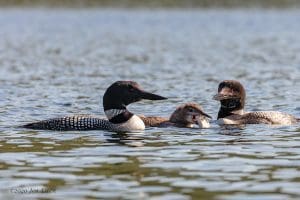
“Maybe that will keep him quiet for a while!”


How does Pablo digest that meal? Loons have strong digestive juices. They also pick up small stones to store in their gizzard for grinding up bones. That is why loons may pick up lead sinkers in place of stones – a tiny amount of lead is fatal.
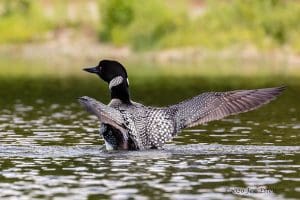
A good stretch before he gets hungry again.
Common Loons are protected by both state and federal laws prohibiting harassment of wildlife
We were out for a sunset kayak ride on Saturday night, watching the moon rise over Mt. Kearsarge. It was almost dark. We were dismayed to witness a kayaker paddling very close to the Loons, seemingly chasing them, and using a flash at close range to photograph them. Using flash in darkness can impair a loon’s vision making it vulnerable to motor boats or other hazards. It is simply unethical to use flash on animals in the dark.
Just a note: Our photos make it look like we are close, but we use 100-400mm zoom lenses and crop our the images during editing. We usually paddle slowly upwind to about 100 feet and then drift by them. Occasionally the Loons come closer on their own. They are familiar with our voices and kayaks. We do not chase them, we leave if they seem bothered, and would never use a flash on them.
Lessons from Backyard Insects
The more we explore the lake and watershed, including our backyard, the more we learn about those we share the planet with. Today, we’ll take a look at some grasshoppers feasting on wildflowers in our meadow. Neat thing about biology is that you can start anywhere and easily connect to just about everything.

Blackeyed Susans (Rudbeckea) petals eaten by grasshoppers.
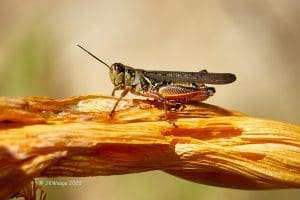
Red-legged grasshoppers are one of several species chomping through the neighborhood. They give us a chance to learn about insect life cycles.
Most insect species go through four life stages – egg, larva, pupa and adult. These include: flies, butterflies and moths, beetles, and ants, bees and wasps. The larval stage varies a lot (caterpillars, grubs, maggots) and, except for caterpillars, you rarely see them. Why most insects? The insects listed above (Diptera, Lepidoptera, Coleoptera, and Hymenoptera), make up about 2/3 of all multicellular animal and plant species on Earth!
The second major insect life history style, shared by things like grasshoppers, crickets, cicadas, mantises and “true” bugs, has just three stages – egg, nymph, and adult. They hatch as miniature adults, but lacking wings. Each time a nymph molts, it gets bigger and so do the “wing buds” that will eventually turn into wings. The final molt to adult releases the fully formed wings.
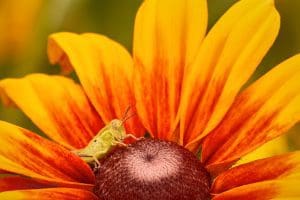
A grasshopper nymph. It has two pairs of wing buds (either side of the black spot) that will become functioning wings on the final molt to adult.
True bugs (Hemiptera) also grow that way. We call them “true” bugs since most people refer to all insects as bugs and this group really are called bugs (with sucking mouthparts and each wing is half hard shell and half membraneous – thus the name hemi = half, ptera = wing). Newly hatched bugs are tiny and lack wings. Aphids are bugs as are spittle bugs that form frothy “nests” to grow in. Below are the juvenile and adult stages of a common plant bug. The wing buds barely reach the nymph’s abdomen.
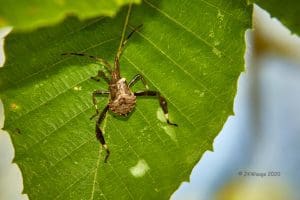
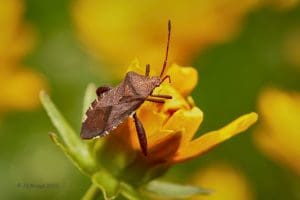
There are some other familiar insects that go through the egg-nymph-adult kind of metamorphosis, but with a neat twist. They spend the nymphal stage underwater with a very different lifestyle than the winged adults. We will explore one example, dragonflies living in Pleasant Lake in a future issue.
Science is about observing things, asking questions and then coming up with possible answers and ways to test among them. A grasshopper you have all seen is a good place to start.
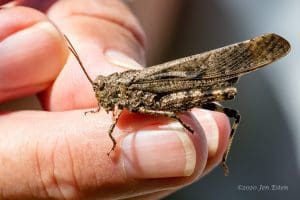
This well camouflaged Carolina Locust (Dissosteira carolina) is probably the grasshopper you have noticed the most, but not while it was hidden on the ground!
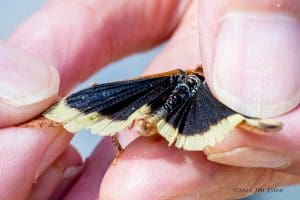
You’ve noticed them when they fly away flashing their black and yellow inner wings and disappearing when they land.
Camouflaged yet sometimes very obvious, what’s going on? Being so hard to see helps avoid predators, but why would they then become so obvious when you approach? Let’s think about some possible answers to “why be so obvious”. First, what do you know about insects and other animals that are displaying yellow or orange and black colors in very obvious ways?

Would you hesitate before getting close to this insect?
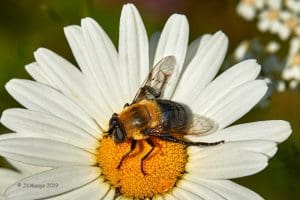
How about this one? Is your first reaction that it is a bumblebee? That first reaction matters. Look closer and you see the two wings. It’s a fly and the top one a wasp.
Bold colors like red, yellow and white in nature tend to make predators hesitate. Maybe our grasshopper gains enough protection by mimicking nasty insects to balance being obvious. But that doesn’t explain why it didn’t just hop away and remain cryptic when you approached.
Second, maybe the grasshopper reacts to you approaching by flying far away, landing and hiding again. But why, then, have those black and yellow underwings? Third, maybe the colors are so important for finding a mate or signaling to another grasshopper that the risk of being seen by a predator is outweighed by the gain of being seen by another grasshopper. Fourth, maybe only the males are the ones taking risks by showing their wings. This occurs in many birds where males are brightly colored and females have cryptic coloration. That turns out to be the easiest possible answer (hypothesis) to test. Since both males and females of this species have colored wings, we can exclude that hypothesis.
What is the answer? We don’t know. There are other hypotheses as well. So many intriguing things in nature are left for us to figure out! Keep looking, thinking and enjoying!
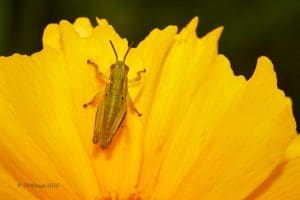
Words and Photos by Jen Esten and Jon Waage
